| Columns Retired Columns & Blogs |
Chario Academy Sovran loudspeaker Measurements
Sidebar 3: Measurements
Footnote 1: In this respect, the Sovran is very similar to Chario's earlier Academy One, reviewed by Larry Greenhill in March 1998.—John Atkinson
The Chario Academy Sovran's voltage sensitivity is specified as a high 90dB/2.83V/m. My B-weighted estimate on the speaker's tweeter axis, calculated by DRA Labs' MLSSA system with a calibrated DPA omnidirectional microphone, was 90.2dB(B)/2.83V/m, which is well within experimental error of the specified figure. However, with an impedance that drops below 4 ohms throughout the midrange and most of the bass, and reaching a minimum value of 2.8 ohms at 90Hz, the Sovran demands a lot of current from an amplifier. The combination of 3.75 ohms and –37° electrical phase angle at 56Hz will also stress optimistically specified amplifiers. Note, by the way, the much higher impedance magnitude throughout the treble compared with the lower frequencies. This will boost the Sovran's high-frequency output when the speaker is used with a tube amplifier, such as MF's Music Reference RM-200.
The traces in fig.1 have a noticeable wrinkle just below 500Hz, which implies the existence of some sort of cabinet resonance in this region. Investigating the two enclosures' vibrational behavior with a plastic-tape accelerometer, I found a single, very strong mode present on all surfaces of the midrange-treble enclosures (fig.2) that was also detectable, though at a much lower level, on the panels of the bass bins. The speakers had been returned to the importer before I analyzed these measurements, but this resonance is so well defined that I suspect it is not actually a panel resonance but is instead due to the interaction between the head-unit's mass and the spring formed by the four compliant rubber feet that separate it from the subwoofer enclosure.
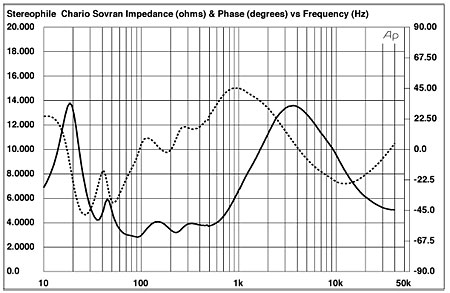
Fig.1 Chario Academy Sovran, electrical impedance (solid) and phase (dashed). (2 ohms/vertical div.)
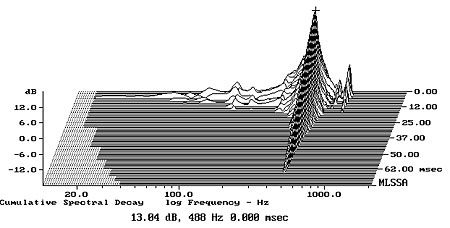
Fig.2 Chario Academy Sovran, cumulative spectral-decay plot calculated from output of an accelerometer fastened to center of head-unit side panel (MLS driving voltage to speaker, 7.55V; measurement bandwidth, 2kHz).
Chario specifies the subwoofer loading as "vented isobaric compound"; looking at fig.1, the shape of the magnitude trace below 100Hz suggests that it is a coupled-cavity type tuned to 36Hz. (The isobaric-loaded drivers fire into an internal cavity that communicates with the outside world via the vents at the bottom of the enclosure side panels.) The red trace in fig.3 shows the subwoofer's output, measured in the nearfield. It comprises a bandpass response peaking in the octave between 40 and 80Hz, with a 24dB/octave, fourth-order rolloff below that region and an initially slower rolloff above it. While some upper-frequency modes are present in its output—always a problem with coupled-cavity loading—these are well down in level.
Turning to the head-unit, the woofer's nearfield output is shown in blue in fig.3, that of the rear-facing port (which was stuffed with foam) in green. Called by Chario a "back-firing slot with aperiodic loading," this tuning is not a classic reflex alignment. There is no minimum-motion notch in the woofer's output, the port's output peaks at the same frequency as the woofer's, and the outputs of the woofer and port appear to be in phase below the port resonance—all of which suggest that the woofer's loading is more akin to a transmission-line. Note the broad overlap between the mid/woofer and the subwoofer, which, as MF points out, is deliberate.
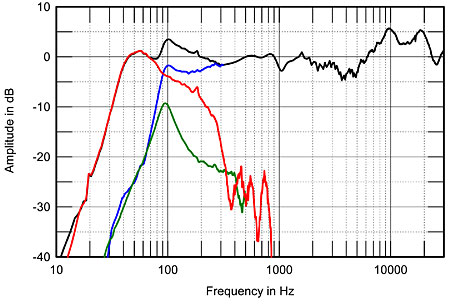
Fig.3 Chario Academy Sovran, anechoic response on tweeter axis at 50" without grille (black), averaged across 30° horizontal window and corrected for microphone response, with the nearfield responses of woofer (blue), head-unit port (green), and subwoofer (red), plotted in the ratios of the square roots of their radiating areas below 300Hz, 500Hz, and 850Hz, respectively, and the complex sum of nearfield responses plotted below 300Hz (black).
Higher in frequency in fig.3, the integration of the woofer and tweeter outputs on the tweeter axis is not quite optimal, this indicated by a lack of energy between 3 and 6kHz. All things being equal, this would give the Sovran's balance a very slightly polite character. However, the top two octaves rise by 6dB or so above the midrange reference level.1 I would have thought this boost to be too high in frequency to be perceived as "bright," though MF did characterize the Sovran's balance as having "a slight tilt toward brightness." He also remarked on the speaker's "exceptional resolution of high-frequency detail" and its highs as being "on the airy, exuberant side," both of which would also result from this measured behavior. The rather clunky grille introduced +3/–6dB irregularities in the Sovran's tweeter-axis response (fig.4); I recommend leaving them off for serious auditioning.
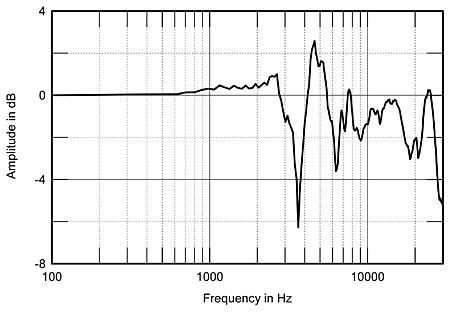
Fig.4 Chario Academy Sovran, effect of grille on the tweeter-axis response.
The Sovran's lateral dispersion (fig.5) is quite even, but there is a touch of off-axis flare at the bottom of the tweeter's passband, between 3 and 5kHz, that will tend to compensate for the lack on on-axis energy in the same region but might add a touch of brightness in lively rooms. As I would have expected from the tweeter's large diameter, its dispersion narrows rapidly above 10kHz, which will work against the audibility of the Chario's top-octave plateau on the tweeter axis. In the vertical plane (fig.6), the response doesn't change by a large amount above or below the tweeter axis, which is 35" from the floor. However, the lack of presence-region energy on the tweeter axis does tend to fill in for listeners who sit higher or lower than that.
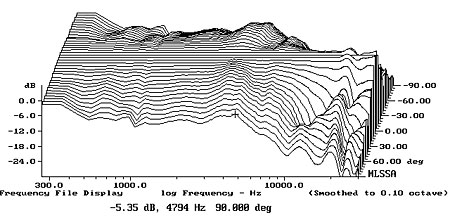
Fig.5 Chario Academy Sovran, lateral response family at 50", normalized to response on tweeter axis, from back to front: differences in response 90–5° off axis, reference response, differences in response 5–90° off axis.
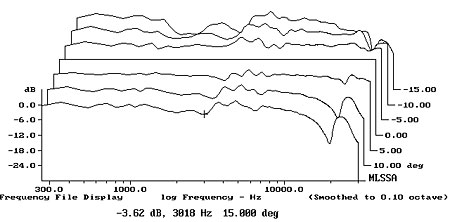
Fig.6 Chario Academy Sovran, vertical response family at 50", normalized to response on tweeter axis, from back to front: differences in response 15–5° above axis, reference response, differences in response 5–15° below axis.
Fig.7 shows how all these quasi-anechoic measurements added up in MF's listening room, with the speakers driven by the Musical Fidelity kW monoblocks. As usually results from the speaker positions Mikey is forced to use, which are fairly close to the room's corners, the midbass region is elevated, with a corresponding lack of upper-bass energy. The lows do usefully extend to 30Hz, however. A slight excess of energy in-room in the middle of the midrange will reduce soundstage depth, but the treble is very flat up to 6kHz, above which the on-axis boost makes its presence known.

Fig.7 Chario Academy Sovran, spatially averaged, 1/6-octave response in MF's listening room.
Turning to the time domain, the Sovran's step response on the tweeter axis is shown in fig.8. The tweeter and mid/woofer are connected in positive acoustic polarity, the subwoofer in inverted polarity. The woofer's output arrives a little late on this axis to integrate properly with the decay of the tweeter's step—inevitable, given the tiltback of the front baffle and the fact that the tweeter is mounted below the mid/woofer—which results in the lack of presence-region energy seen in the on-axis frequency response. The cumulative spectral-decay plot on the tweeter axis (fig.9) is superbly clean overall.

Fig.8 Chario Academy Sovran, step response on tweeter axis at 50" (5ms time window, 30kHz bandwidth).

Fig.9 Chario Academy Sovran, cumulative spectral-decay plot on tweeter axis at 50" (0.15ms risetime).
While some aspects of the Chario Academy Sovran's design puzzled me a little, overall it performed very well on the test bench.—John Atkinson
Footnote 1: In this respect, the Sovran is very similar to Chario's earlier Academy One, reviewed by Larry Greenhill in March 1998.—John Atkinson
- Log in or register to post comments




































